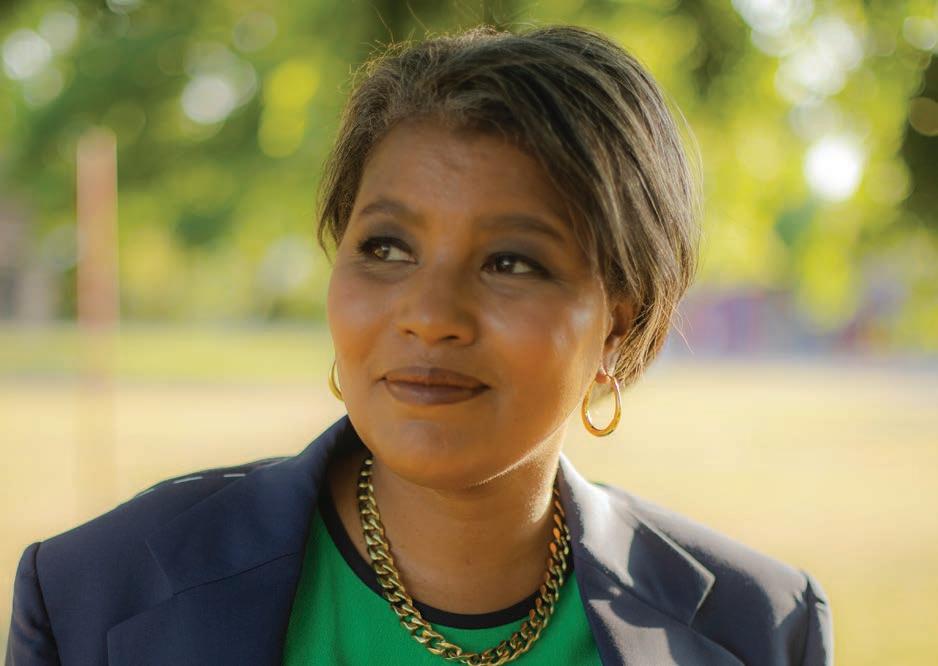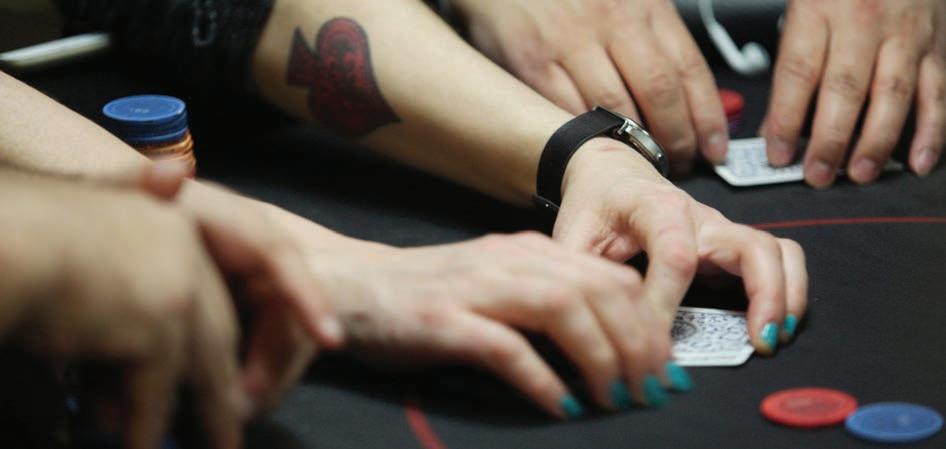
20 minute read
want a white savior
MISS LOPEZ MEDIA
THE WRITE STUFF: Teressa Raiford is doing little campaigning for her write-in candidacy but has vocal support from activists. The Third Way
Advertisement
Teressa Raiford isn’t on the November ballot. Many Portland activists want her to be mayor anyway.
BY AARON MESH
amesh@wweek.com
Back in May, Teressa Raiford’s yearslong bid to be Portland mayor appeared over. Raiford, 50, announced her challenge of Mayor Ted Wheeler in late 2017, the year he first took office. In the primary this May, in a fi eld of 19 candidates, she got 8.5% of the vote, fi nishing a distant third behind Wheeler and Sarah Iannarone. Then Minneapolis police killed George Floyd. Starting May 28, Portlanders took to the streets by the thousands to protest the police killings of Black people. With six weeks remaining until Election Day, those protests continue. For Raiford, such protest is nothing new. For most of the decade, she has shepherded demonstrators who decry the actions of police. She has confronted elected officials in City Council chambers and consoled the families of people shot by o cers. This summer, her nonprofi t organization, Don’t Shoot Portland, successfully went to court to limit the cops’ use of tear gas. The issue she has spent much of her life championing— police accountability—has never been more prominent. So in July, her campaign volunteers asked a question: Why shouldn’t she be mayor? “She has been doing the work that a mayor should have been doing,” says Jacinda Padilla, Raiford’s campaign manager. “After so much turmoil, people didn’t know that she was running for two years, and we didn’t want that work to go to waste. People who didn’t even vote for Teressa in the primaries started to turn back to Teressa.” So increasingly, the city is plastered with posters featuring an illustrated portrait and a demand: “Write in Teressa Raiford.” Raiford declined to be interviewed for this story, saying her campaign staff could speak for her. Those volunteers say Raiford’s experience as a Black woman whose family has endured racism and violence as well as her activism and outreach make her the right candidate for the times. Susan Anglada Bartley, an educator, writer and activist, is among the supporters of the write-in campaign. “Teressa Raiford has so much talent and expertise,” Anglada Bartley says. “She is a multidimensional person and frankly a superior candidate, especially for this political moment.” That’s frustrating for Iannarone, who is trying to position herself to Wheeler’s left and whose campaign has repeatedly scuffled with Raiford’s backers online. But it also displays the divergent views among Portland progressives over what result should come from four months of protests. If the mayoral election is a referendum on the future of the Portland Police Bureau, the three candidates o er competing visions. Wheeler calls for balance: He celebrates the promotion of a Black man, Chuck Lovell, to police chief and the cutting of $15 million from the bureau’s budget but says the police force is needed to ensure public safety. Iannarone seeks wholesale reform and says Wheeler’s changes don’t go far enough. Raiford? She wants to dismantle the bureau and replace it with something better. “If you know anything about Teressa, she’s not a traditional candidate,” says Token Rose, a community organizer who is volunteering for Raiford. “She’s for [police] abolition. She’s calling for defunding of police. She’s calling for radical ideas. That’s always been Teressa, that’s always been her niche in Portland, and after May 19 people started to listen.”
Raiford grew up in Portland. Her family owned the Burger Barn, a Northeast Portland restaurant that in 1981 was the target of a notorious incident: Two off-duty Portland police officers tossed four dead opossums on its doorstep. In her 20s, she moved with her two children to Dallas, Texas, where she worked as a manager at Bank of America. In 2010, she returned to Portland, shortly before her nephew was killed in an unsolved shooting. That death propelled her into activism. The group she founded, Don’t Shoot Portland, seeks to comfort and organize the survivors of gun violence—particularly shootings by police. In 2016, she formed a nonprofit. (Don’t Shoot Portland’s most recent fi ling with the state, in 2019, reported an annual revenue of $36,407; Raiford, the executive director, received no salary.) Raiford has sought o ce before. She challenged City Commissioner Amanda Fritz in 2012, receiving 3.2% of the vote. She sought to unseat former Multnomah County Commissioner Loretta Smith in 2014 (she got 6.6%) and ran a write-in campaign for Multnomah County sheri in 2016 (3.2%). Meanwhile, she drew a fiercely loyal following of Black activists for her organizing, especially during protests of the police shooting of Michael Brown in Ferguson, Mo., in 2014. She was arrested marching to a Bernie Sanders presidential rally in 2015. Charges were dismissed, and she sued the police for allegedly targeting her for her statements. A judge dismissed the case last year. Destiny Houston, an activist, doula, and organizer with the Kid-Centered March for Black Lives, says that history is part of Raiford’s appeal. “Going through being harassed by the police and all the trials, she’s somebody who can represent the Black experience in a police state,” Houston says. “Her whole mission is to create a society where people aren’t losing people to police violence.” Raiford took Don’t Shoot Portland back to court this summer, joining a class action lawsuit seeking a temporary restraining order against Portland police use of tear gas at protests. (A judge ruled partly in favor of demonstrators.) The group is currently suing the U.S. Department of Homeland Security over President Trump’s deployment of federal police to guard the downtown courthouse. Under Raiford’s leadership, Don’t Shoot Portland in July took organizational leadership of the most prominent display of resistance to Trump: the “Wall of Moms,” a group of yellow-clad women who faced o in gas masks each night with federal o cers. When that group dissolved amid internal rancor, Raiford founded another: Moms United for Black Lives. Don’t Shoot Portland also briefly ran an all-you-can-eat, donations-only barbecue for protesters called Riot Ribs, until that operation also ended after organizers said an outsider hijacked it. Raiford’s volunteers say she isn’t spending much time campaigning. Instead, she’s focused on mutual aid efforts—that is, projects where citizens help each other through di cult times. This month, during massive wildfires, Don’t Shoot Portland organized a donations drive to send air filters, personal protective equipment, and menstrual hygiene products to smokeclogged neighborhoods on the edge of the city and the Warms Springs Reservation, where the Lionshead Fire raged. Not everyone is impressed. Commissioner Jo Ann Hardesty, the most vocal critic of police on the City Council, quarreled with Raiford in 2016 during debate over a new police contract. “Last time I had a conversation with her, we were in City Council chambers,” Hardesty recalls. “She started attacking me. She said, ‘The NAACP is just sucking up the all the money; you’re going to jail.’ I said, ‘The only way I’m going to jail is if I kick your butt.’” Hardesty hasn’t endorsed in the mayor’s race. But she doesn’t support Raiford. “I don’t find her someone that I would want to deal with,” Hardesty says. Some members of Raiford’s coalition raise eyebrows. She has the backing of key members of Stop Demolishing Portland, a group of homeowners who oppose infi ll development. Few people could fi nd Raiford’s write-in campaign as frustrating as Iannarone, whose campaign is trying to unite the left against Wheeler, only to find that some activists prefer Raiford, whom Iannarone thought she had already defeated. “I respect her work,” Iannarone says, “and we just had an election in May after she campaigned for several years, and she didn’t break 10% of the vote. My singular focus this whole time has been on unseating Wheeler. And that’s what I intend to stay focused on.” Anglada Bartley, the Raiford supporter, says Iannarone’s candidacy is ill-timed. “Given that she is, like myself, a white woman, she can’t say she really understands all forms of marginalization Black and Indiginous people feel,” she says. “That is knowledge Teressa Raiford walks in the door with.” Rose is more blunt. “People think that we owe something to Sarah,” they say. “And we don’t. She will never be the face of our revolution. We didn’t ask for a white savior, and we didn’t show up to protest for a hundred days now, risking all of our lives, for another white savior. We asked for Black lives to matter. “Teressa had been talking about police brutality,” Rose adds. “People are actually starting to see it. And so people are asking for ways to show up for Black lives. So now we’re providing those answers. People noticing us is a win. Of course we’re going to win. We anticipate winning, 1,000%.” Nigel Jaquiss contributed reporting to this story.
SUPPORT LOCAL INDEPENDENT JOURNALISM

BECOME A FRIEND OF WILLAMETTE WEEK WWEEK.COM/SUPPORT




Gambling Men
A risk assessor says the state of Oregon lost court cases it should have settled—and punished her for speaking up.
BY TESS RISKI
tess@wweek.com
In a whistleblower lawsuit fi led Sept. 10 in Marion County Circuit Court, a longtime state employee accuses the Oregon Department of Administrative Services of retaliating against her for complaining about the Oregon Department of Justice. It’s an unusual lawsuit, because the plaintiff claims her bosses didn’t back her up in a dispute with another state agency. Her claim: that DOJ ignored her advice and unnecessarily litigated cases that resulted in jury verdicts against the state. In addition, the plainti claims that DOJ lawyers treated women with contempt. Shauneen Scott is a 35-year employee of the state of Oregon. Since 2015, she has worked as a risk manager for the Department of Administrative Services. Scott was responsible for reviewing complex liability claims against the state and determining whether to pay or negotiate the claims—or ask the DOJ take them to court. Hundreds of people threaten to sue the state each year. The DAS evaluates those legal claims, and decides whether the state is more likely to lose money by paying out a settlement or going to trial. In e ect, risk managers perform for the Department of Justice the role an insurer often plays for a private company—they evaluate potential loss and decide whether a trial is worth the gamble. But Scott alleges she witnessed a “pattern and practice of violations by attorneys from DOJ” that included DOJ lawyers determining “without authority” whether a case should settle and the dollar amount of the settlement. Scott says DOJ lawyers routinely denied her o ce the ability to settle claims for a “low and reasonable amount” and instead determined that cases should go to trial, resulting in what Scott described as unnecessary million-dollar losses. What’s more, the DOJ lawyers would then continue to bill and collect attorney fees from the state’s risk management division. “Despite having no legitimate defenses and recognizing that a high-dollar jury award was likely, DOJ insisted that if plainti ’s attorneys were going to get a large amount of money, they would have to ‘work’ for it by going to trial,” the complaint says. “As a result, the state unnecessarily loses millions of dollars after jury verdicts or ends up paying higher settlements just before trial that could have been avoided had prior settlements been reached.” Scott alleges her superiors at the Department of Administrative Services allowed this practice to occur despite its strain on the state’s resources. She does not cite specifi c cases. Scott’s lawsuit claims she raised concerns with her supervisor and was retaliated against by having her workload reduced signifi cantly and being scrutinized di erently than her colleagues. Scott is suing her employer, DAS, for retaliation. She’s seeking $700,000 in non-economic damages, including embarrassment, anxiety, humiliation, emotional distress, damage to her professional reputation and loss of enjoyment of life. “Our client has leveled serious accusations that should be of maximum importance to the citizens of this state,” Scott’s attorney, Shannon Rickard, tells WW. “She looks forward to the opportunity to prove her claims in a court of law.” DAS declined to comment, citing pending litigation. Scott’s complaint also says that DOJ lawyers are “dismissive of women” and treated her with condescension. It suggests they lost taxpayer money by underestimating the women they faced in court. She says male leadership at the DOJ described opposing female lawyers as “nothing more than support staff ” and that trial leadership and trial lawyers regularly make “unsupported, racially discriminatory, and defamatory statements about opposing attorneys and victims who bring cases against the state.” That’s the second time this summer that a legal claim cites a misogynistic culture within the DOJ. (A tort claim filed June 29 by Oregon DOJ trial lawyer Heather Van Meter accuses her supervisor Marc Abrams of sexual harassment and lead DOJ trial lawyer Steve Lippold of sexist comments and behavior.) Attorney General Ellen Rosenblum has described gender equity as one of her top priorities, which makes the complaints unsettling. (Disclosure: Rosenblum is married to the co-owner of WW’s parent company.) In a joint statement issued in response to questions from WW, Rosenblum and Deputy Attorney General Fred Boss pledged an investigation into claims made in the lawsuit and said the agency is committed to fostering a professional and safe environment “free of discrimination or harassment of any kind.” “It is, of course, disheartening to learn that anyone thinks we are not living up to these standards,” Rosenblum and Boss said. “We commit to looking fully into the allegations of Ms. Scott’s complaint that pertain to DOJ and, if appropriate, to making improvements to our settlement processes and workplace—to align them with the ‘gold standard’ of conduct and service we aspire to.”
GOOD GRIEF
In 2020, everyone is struggling with mental health. Here’s our guide to finding peace.
“How could 2020 get any worse?”
Whenever someone, somewhere, writes or mumbles or scream-cries that question, the forces controlling this godforsaken year seem to take it as a challenge.
Once-in-a-lifetime global health crisis not trau- matic enough for you? How about we add 100 nights of confrontations between protesters and tear gas-happy police? Let’s throw catastrophic wildfires and histor- ically dangerous air quality on top of that. And then, just as the smoke dissipates and the sky reappears… Ruth Bader Ginsburg is dead!
What’s next? Murder locusts? Biblical floods? Or maybe just a contentious presidential election that’s guaranteed to have most of us breathing into a paper bag as the results come in?
In the best of times, everyone could probably use therapy. But right now, no one can claim to be doing fine.
That’s why, with the arrival of fall—and in this part of the country, the start of six months of rain, darkness and seasonal depression—we’ve dedicated this issue to helping you find some level of serenity in the madness of 2020.
For some, that might mean eating a giant bowl of mac-and-cheese at 2 in the morning (page 15), or tak- ing hallucinogenic mushrooms and tripping the stress away (page 14). Under the right conditions, both are valid forms of self-care. So we spoke to proponents of psilocybin therapy—which Oregon voters have the chance to legalize in November—and a doctor working to redefine what it means to be truly healthy.
We’ve also paid particular attention to the mental and physical well-being of Portland’s BIPOC com- munity, who’ve been on the front lines of the fight for racial justice not just for the last four months but the past four centuries. We talked to a psychologist work- ing to establish a therapy network specifically for Black Lives Matter supporters (page 16), and the organizer of a pop-up offering multiple forms of healing to protest- ers—for free (page 17).
Again, though, we’re all going through this year together, including mental health experts. On the fol- lowing page, we asked a dozen therapists, counselors, yoga instructors and others in the healing field about their own methods for coping with...everything.
Hopefully, you can cull some strategies for main- taining over the next three months. Because precedent says 2020 definitely can get worse. But with the right tools, we can get through this year, and whatever comes after. —Matthew Singer, Willamette Week A&C Editor

Catherine Nyhan
Therapist First off, it is important to remember that we are all in a place of collective grief during this time. This means that we may feel and behave like we are grieving. This is a cyclical experience, and the first suggestion I make is to first acknowledge what is happening and wherever you are in it, whether that be anger, rebellion, depression, anxiety, sadness, numbness, shutdown or business. Battle fatigue and compassion fatigue are real and come with true exhaustion. Knowing that there is no way we can perform at the level we were before the coronavirus hit is a form of radical acceptance. This means we start with the basics: Eating, drinking, showering, getting dressed as if you have somewhere to go can help. Think about preparing for the winter in Oregon by planning indoor activities, ways to get exercise, ways to create outlets for fun, and community—try a soup swap or some way to stay in contact with people. Finally, I recommend that you consider taking additional minerals as our bodies are burning a lot of them with the stress that we are under.
Vanessa Washington
Counselor My main focus has been to shift what I’m exposed to on a regular basis. I limit when I listen to the news and monitor how often I’m getting on to social media. This reduces the number of times my heart and brain have to track and absorb crisis information. When I can’t lean out of TV, news and social media, I make sure I’m following accounts that are committed to Black joy and wellness and celebrating the full humanity of my culture and identity. I’m also working on creative routines that give my heart and my brain other things to track and absorb—like specific times where I’m vibing to a song or performance instead of the thoughts trying to consume me. I also just got some roller blades to mess around with, so I’ll be out rolling in these streets soon.
Crystal Davis
Holy Fire reiki master teacher This year has been difficult for all of us and our nervous systems. I have navigated this year with daily breath work to support my lungs, lemon water in the morning for energy, meditation to calm my mind, and journaling to stay in touch with my heart. I define spirituality as being in relationship with something bigger than myself—the forces that connect and keep me in conversation with the whole of existence. This can look like feeling the earth beneath my feet when I’m out for a walk, the sensation of breeze, the sun on my face, or listening for the pulse of my heartbeat. I observe how those experiences create change in how I feel. For me, this is at the core of mindfulness.
Liz Eisman
Instructor, Living Yoga I believe we all need to connect with something larger. Feeling the earth, smelling the dirt, watching squirrels, collecting bird feathers, connecting with my neighbors when I walk my dog have all been a part of my resiliency practice. In addition, I remind myself—and even challenge myself—to reach out when I am starting to feel isolated or deflated. I feel my feelings while also looking for opportunities to see humor and feel gratitude. I march when I can march, make calls when I can make calls, and sleep when I can sleep. And I literally use my eyes to widen my perspective: I focus broadly and set my eyeballs deeper in my sockets so I can settle deep inside myself as I meet the outer world.
Tim Osborn
Lead pastor, Mosaic Church Bulletproof coffee first thing in the morning. This means I don’t need to fix breakfast and it gives me more time for reading. Each morning includes a few pages of a narrative Bible and then something related to our nation’s history of racial wrongs: The Warmth of Other Suns, The Cross and the Lynching Tree, Between the World and Me. I also don’t touch my phone, the internet or social media until I’m done reading. This allows intentional space for peace as the day begins.
”I REMIND MYSELF— AND EVEN CHALLENGE MYSELF— TO REACH OUT WHEN I AM STARTING TO FEEL ISOLATED OR DEFLATED.“ —LIZ EISMAN
Brita Britnell
Health food influencer Like everyone, I’ve really struggled to stay sane throughout 2020. What has helped me a lot is to give myself small things to look forward to. For me, those are usually trips, but since travel is limited, I’ve had to get creative. Something as simple as a virtual cooking class or apple picking with family has helped break up the workweeks and given me something fun to really look forward to—plus, I end up with apple pie. When all else fails, a nice evening on the couch playing Animal Crossing always makes me feel better.
Valerie Yeo
Psychologist Since the start of the pandemic, I have been trying to remember a line I often repeat to my therapy clients, that there is no way we “should” feel other than how we feel in the moment. Anxiety is a normal reaction to ongoing trauma. We live in a culture that loves to prescribe activities we should do to make ourselves feel better. However, this type of self-care approach can covertly foster shame that we are doing yet another thing in the wrong way, or not doing enough. Rather than a prescriptive approach, I find it is more helpful to attune to what we may need in each moment, and to recognize that it is subject to change. Also salient in this particular moment is that those who hold marginalized identities are experiencing a significantly greater impact from this collective trauma. As a woman of color in a helping profession, I often feel the urge to take on more in order to feel like I am doing enough, and feel easily burned out as a result. During this season, I am trying to remember to embrace rest as a part of my work.
Kathryn Mathew
Holistic nutritionist I have found it helpful to take one day at a time. I give myself unconditional permission to feed, rest and move my body in ways that bring me comfort and joy when possible. Going barefoot in the grass or the garden almost daily has been another comforting anchor. I honor that there are moments in time that feel rough and it’s OK for it to feel that way. Be gentle with yourself.
Anjuji Shah-Johnson
Therapist Personally, I have been focusing on trying to find moments—often literally minutes—of stability and balance internally and externally. Externally, maintaining and building new connections with others to keep hold of a sense of community. Internally, I use a practice that I learned a few years ago of balancing energy and breath in my body, focusing on the left and right sides of my body, then the front and back and finally the upper and lower halves of my body. I also do a ton of reminding myself and those I am in contact with that intense and/or unusual responses are very much in line with these intense and unusual times.
Toni Cornett
Yoga therapist I’ve focused on the little things, as it’s the little things that save us. The moments people tend to take for granted are usually the moments of the most value: morning tea time, socially distanced dance parties, slow walks around the neighborhood. (Sounds like a dating profile.) Give gratitude for the people in your life. Notice all that you do have. It’s an unprecedented time, but even so there’s always one thing to be grateful for.
Annie Lauren Rosen
Yoga instructor On an exhale, allow the tongue to fall from the roof of the mouth and the lips to part slightly. This is the mechanical relaxation of the jaw and a signal from body to brain that you are well and safe. Engage the muscles between the shoulder blades, while softening the shoulders, and you have a posture that says to the brain, “I am openhearted. I have everything I need. I am curious rather than afraid.”
Ronkwahrhakónha Dube
Counselor All I can say is, do what you can and forgive yourself if you can’t.











